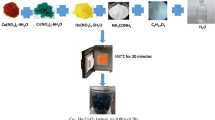Abstract
Ceramics based on 0.5ZrO2-0.5TiO2 were evaluated as humidity sensors. The variation of phase change, microstructure, and conductivity with relative humidity were investigated for base ceramics doped with additives such as CrO1.5, FeO1.5 and MgO. It was found that FeO1.5 enhanced the formation of ZrTiO4. The addition of MgO and FeO1.5 increased conductivity and its humidity sensitivity. Open porosity was not affected much by the addition of the three dopants. Nitrogen treatment of sintered ceramics at 900 °C was found to increase conductivities and humidity sensitivity of the ceramics.
Similar content being viewed by others
References
F. W. Dunmore,J. Res. Nat. Bur. Stand.23 (1939) 701.
K. Nakamura, K. Ono andK. Kawada,Electroanalytical Chem. Interfacial Electrochem.47 (1974) 175.
K. W. Misevich,IEEE Trans.IECE-16 (1969) 6.
P. E. Thomas, J. O. Colla andR. Stewart,IEEETrans.CHMT-2 (1979) 231.
T. Nitta, Z. Terada andS. Hayakawa,J. Amer. Ceram. Soc.63 (1980) 295.
T. Seiyama, N. Yamazoe andH. Arai,Sensors andActuators4 (1983) 85.
R. T. Johnson Jr andR. M. Biefeld,Mater. Res. Bull.14 (1979) 537.
H. Arai, S. Ezaki, Y. Shimizu, O. Shippo andT. Seiyama, in “Proceedings of the International Meeting on Chemical Sensors”, Fukuoka, 1983, edited by T. Seiyama, K. Fueki, J. Shiokawa and S. Suzuki (Kodansha, Tokyo and Elsevier, Amsterdam, 1983) p. 393.
T. Nitta, F. Fukushima andY. Matuo,ibid. p. 287.
Y. Yokomizo, S. Uno, M. Harata andH. Hiraki,Sensors and Actuators4 (1983) 599.
T. Yamamoto andH. Shimizu,IEEE Trans.CHMT-5 (1982) 238.
T. Nitta andS. Hayakawa,ibid.CHMT-3 (1980) 237.
Y. Shimizu, H. Arai andT. Seiyama,Sensors and Actuators7 (1985) 11.
S. Mokude andH. Futata, in “Proceedings of the 2nd International Meeting on Chemical Sensors”, Bordeaux, 1986, edited byJ.-L. Aucouturier, J.-S. Cauhape, M. Destrian, P. Hagenmuller, C. Lucat, F. Meril, J. Portier andJ. Salardenne (Université Bordeaux, Bordeaux, 1986) p. 349.
J. C. Wu, C. S. Chung, C. L. Ay andI. K. Wang,J. Catal.87 (1984) 98.
P. A. Lessing, G. R. Miller andH. Yamada,J. Electrochem. Soc.133 (1986) 1537.
P. A. Lessing, Z. Z. Yang, G. R. Miller andH. Yamada,J. Electrochem. Soc.135 (1988) 1049.
K. Katayama, T. Akiba andH. Yanagida, in “Proceedings of the International Meeting on Chemical Sensors”, Fukuoka, 1983, edited by T. Seiyama, K. Fueki, J. Shiokawa and S. Suzuki (Kodansha, Tokyo and Elsevier, Amsterdam, 1983) p. 393.
Author information
Authors and Affiliations
Rights and permissions
About this article
Cite this article
Yang, S.L., Wu, J.M. ZrO2-TiO2 ceramic humidity sensors. J Mater Sci 26, 631–636 (1991). https://doi.org/10.1007/BF00588297
Received:
Accepted:
Issue Date:
DOI: https://doi.org/10.1007/BF00588297




